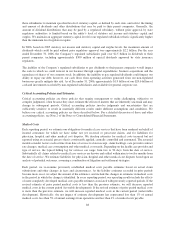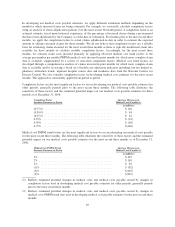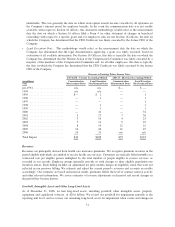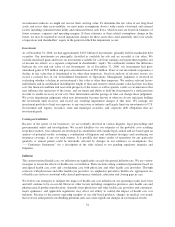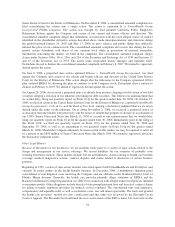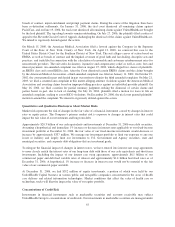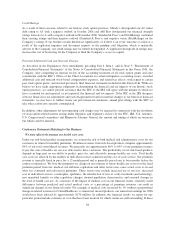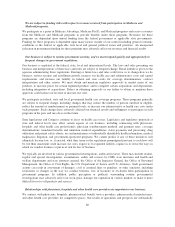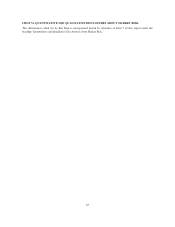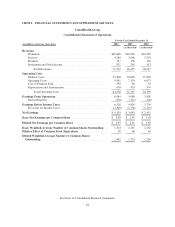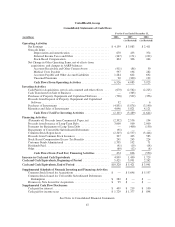United Healthcare 2006 Annual Report Download - page 60
Download and view the complete annual report
Please find page 60 of the 2006 United Healthcare annual report below. You can navigate through the pages in the report by either clicking on the pages listed below, or by using the keyword search tool below to find specific information within the annual report.Credit Ratings
As a result of their concerns related to our historic stock option practices, Moody’s downgraded our A2 senior
debt rating to A3 with a negative outlook in October 2006 and AM Best downgraded our financial strength
ratings from A+ to A with a negative outlook in November 2006. Standard & Poor’s and FitchRatings confirmed
their existing ratings and their negative outlook (Standard & Poor’s) and negative watch (FitchRatings) on the
Company’s ratings. If our business results deteriorate significantly, or if there is an event, outcome or action as a
result of the regulatory inquiries and document requests or the pending civil litigation, which is materially
adverse to the Company, our credit ratings may be further downgraded. A significant downgrade in ratings may
increase the cost of borrowing for the Company or limit the Company’s access to capital.
Potential Additional Cash and Noncash Charges
As described in the Explanatory Note immediately preceding Part I, Item 1, and in Note 3 “Restatement of
Consolidated Financial Statements” of the Notes to Consolidated Financial Statements in this Form 10-K, the
Company, after completing its internal review of the accounting treatment of all stock option grants and after
consultation with the SEC’s Office of the Chief Accountant on certain interpretive accounting issues, recorded
additional cash and noncash stock-based compensation expenses, and related tax effects, with regard to certain
past stock option grants, and restated previously filed financial statements included in this Form 10-K. While we
believe we have made appropriate judgments in determining the financial and tax impacts of our historic stock
option practices, we cannot provide assurance that the SEC or the IRS will agree with the manner in which we
have accounted for and reported, or not reported, the financial and tax impacts. If the SEC or the IRS disagrees
with our financial or tax adjustments and such disagreement results in material changes to our historical financial
statements, we may have to further restate our prior financial statements, amend prior filings with the SEC, or
take other actions not currently contemplated.
In addition, other adjustments for non-operating cash charges may be required in connection with the resolution
of stock option-related matters arising under litigation, and regulatory reviews by the SEC, IRS, U.S. Attorney,
U.S. Congressional committees and Minnesota Attorney General, the amount and timing of which are uncertain
but which could be material.
Cautionary Statements Relating to Our Business
We must effectively manage our health care costs.
Under our risk-based product arrangements, we assume the risk of both medical and administrative costs for our
customers in return for monthly premiums. Premium revenues from risk-based products comprise approximately
90% of our total consolidated revenues. We generally use approximately 80% to 85% of our premium revenues
to pay the costs of health care services delivered to these customers. The profitability of our risk-based products
depends in large part on our ability to predict, price for, and effectively manage health care costs. Total health
care costs are affected by the number of individual services rendered and the cost of each service. Our premium
revenue is typically fixed in price for a 12-month period and is generally priced one to four months before the
contract commences. We base the premiums we charge on our estimate of future health care costs over the fixed
premium period; however, medical cost inflation, regulations and other factors may cause actual costs to exceed
what was estimated and reflected in premiums. These factors may include increased use of services, increased
cost of individual services, catastrophes, epidemics, the introduction of new or costly treatments and technology,
new mandated benefits or other regulatory changes, insured population characteristics and seasonal changes in
the level of health care use. As a measure of the impact of medical cost on our financial results, relatively small
differences between predicted and actual medical costs as a percentage of premium revenues can result in
significant changes in our financial results. For example, if medical costs increased by 1% without a proportional
change in related revenues for UnitedHealthcare’s commercial insured products, our annual net earnings for 2006
would have been reduced by approximately $170 million. In addition, the financial results we report for any
particular period include estimates of costs that have been incurred for which claims are still outstanding. If these
58


